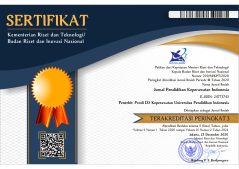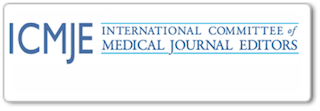Development and Preliminary Validation of NIHSS-SDKI and CNS-SDKI Tools for Nursing Diagnosis in Stroke Care
Abstract
Introduction: Accurate assessment of stroke severity is a critical component of nursing care. The NIHSS and CNS are standardized neurological instruments commonly used to evaluate stroke severity. Integrating NIHSS and CNS with the Indonesian nursing diagnosis standard (SDKI) offers practical benefits for nurses, as SDKI is tailored to the conditions of patients in Indonesia. Objective : The objective of this study is to evaluate the effectiveness of combining NIHSS and CNS severity assessments with SDKI in improving the accuracy of nursing diagnoses and determining stroke severity in patients. Methods: The research design used was Randomized Controlled Trial (RCT), single blind. The sample consisted of 55 stroke patients admitted to the neurological care unit using probability sampling technique with a simple random sampling approach, where sampling was carried out in accordance with predetermined inclusion criteria: non hemorrhagic stroke patients, respondents' age > 18 years, and willing to become research subjects. Assessment of severity was carried out using the NIHSS and CNS instruments, which were combined with the SDKI to determine nursing diagnoses. Assessment was carried out for 5 days of patient care. Results: Mann-Whitney test analysis in the NIHSS group and CNS group showed a p-value> (0.05), meaning that there was no difference between the application of NIHSS and CNS assessment on determining the degree of severity and the number of nursing diagnoses in stroke patients. Conclusions: This study shows that both NIHSS-SDKI and CNS-SDKI are effective in detecting changes in the clinical condition of stroke patients from day one to day five.
Keywords
Full Text:
PDFReferences
Bushnell, C.D., Johnston, S.D. & Goldstein, L.B. (2001). Retrospective Assessment of Initial Stroke Severity. Comparison of the NIH Stroke Scale and the Canadian Nuerological Scale. American Heart Association. 656-660
Chalos V, van der Ende NAM, Lingsma HF, et al. National Institutes of Health Stroke Scale: An Alternative Primary Outcome Measure for Trials of Acute Treatment for Ischemic Stroke. Stroke. 2020;51(1):282-290.
Côté, R., Battista, R. N., Wolfson, C., Boucher, J., Adam, J. and Hachinski, V. (1986). The Canadian Neurological Scale. Neurology, Vol. 39, No. 5, 638–638.
Damhudi, D. (2012). Efektifitas penggunaan metode NIHSS dan ESS dalam pembuatan diagnosis keperawatan yang aktual pada pasien stroke fase akut. Jurnal Keperawatan Indonesia, Vol 15, No. 1, 7-12.
Darmanto, J., Bayhakki. and Gusti. P.R. (2023). Hubungan pengetahuan dengan perilaku perawat dalam menggunakan nihss pada pasien stroke di ruangan stroke unit. Jurnal Keperawatan Jiwa. Vol. 11, No. 3, 739-746.
Farooque, U., et al. (2020). Validity of national institutes of health stroke scale for severity of stroke to predict mortality among patients presenting with symptoms of stroke. Cureus, Vol.12, No.9, 1–11.
George, M. G. (2020). Risk factors for ischemic stroke in younger adults: A focused update. Stroke, Vol. 51, 729-735.
Halina, S.N., Faizah, I., Putri, R.A.P, Sari, R.Y. & Rohmawati, R. (2023). Analisis faktor yang berhubungan dengan ketepatan penegakan diagnosa keperawatan menurut standar diagnosis keperawatan Indonesia (SDKI). Jurnal Keperawatan Stikes Kendal, Vol. 15, No. 1. 389-398.
Huang, Y. et al. (2015). Association between job strain and risk of incident stroke. American Academy of Neurology. 1-7
Kerr DM, Fulton RL, Lees KR. (2012). Seven-day NIHSS is a sensitive outcome measure for exploratory clinical trials in acute stroke: evidence from the Virtual International Stroke Trials Archive. Stroke. Vol. 43, No. 5. 1401-1403.
Mirawati, D. and Mutawasitoh. A.A. (2024). Hubungan Tingkat Pendidikan dengan Pengetahuan Stroke pada Lansia. Jurnal Ilmiah Ilmu Kesehatan, Vol 12, No. 1, 114-124.
Mohtar, M. S., Rahman, S., Apriannor, A. dan Auliyah, G. R. (2022). The Effectiveness of the Siriraj Stroke Score (SSS) and National Institute of Health Stroke Scale (NIHSS) Assessment Methods in Determining the Actual Nursing Diagnosis of Stroke Patients in the Emergency Room. Jendela Nursing Journal, Vol. 6, No. 2, 101-113.
Nilanont, Y., et al (2010). The canadian neurological scale and the NIHSS: Development and validation of a simple conversion model. Cerebrovascular Diseases, Vol. 30, No.2, 120–126.
Rasyid, A & Soertidewi, L. (2020). Unit stroke: Manajemen stroke secara komprehensif. Jakarta: Balai Penerbit Fakultas Ilmu Kedokteran.
Saposnik, G. (2011). Stroke Outcomes Research Canada, Improving Access and Quality of Stroke Care Across Canada. Canadian Neurological Scale (CNS). CNS - ISCORE - SORCan
Siniscalchi, A. (2022). Use of stroke scales in clinical practice: current concepts. Turkish Journal of Emergency Medicine, Vol 22, No, 3, 119-124.
Tim Pokja SDKI DPP PPNI. (2017). Standar Diagnosis Keperawatan Indonesia Definisi dan Indikator Diagnostik. Jakarta: Dewan Pengurus PPNI
Yahya, T., Jilani, M. H., Khan, S. U., Mszar, R., Hassan, S. Z., Blaha, M. J., Blankstein, R., Virani, S. S., Johansen, M. C., Vahidy, F., Cainzos-Achirica, M., & Nasir, K. (2020). Stroke in young adults: Current trends, opportunities for prevention and pathways forward. American journal of preventive cardiology, Vol. 3, 100085.
DOI: https://doi.org/10.17509/jpki.v11i1.75627
Refbacks
- There are currently no refbacks.
Jurnal Pendidikan Keperawatan Indonesia(JPKI) published by Indonesia University of Education. JPKI is licensed under a Creative Commons Attribution-ShareAlike 4.0 International License.
Office :
Nursing Department. FPOK UPI.
229, Dr. Setiabudhi Street. Bandung 40154
West Java , Indonesia
E-mail : jpki@upi.edu

_.png)
_.png)
_.png)











